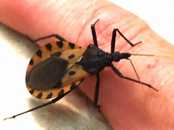Insects

Triatomine bugs are the vectors for Chagas disease.
An insect that transmits a disease is known as a vector, and the disease is referred to as a vector-borne disease. Insects can act as mechanical vectors, meaning that the insect can carry an organism but the insect is not essential to the organism’s life cycle, such as when house flies carry organisms on the outside of their bodies that cause diarrhea in people. Insects can also serve as obligatory hosts where the disease-causing organism must undergo development before being transmitted (as in the case with malaria parasites).
Vector-borne transmission of disease can take place when the parasite enters the host through the saliva of the insect during a blood meal (for example, malaria and dengue), or from parasites in the feces of the insect that defecates immediately after a blood meal (for example, Chagas disease). Parasites transmitted by insects often circulate in the blood of the host, with the parasite residing in and damaging organs or other parts of the body.
|
Disease* |
Parasite |
Insect (vector) |
| African trypanosomiasis (sleeping sickness) | Trypanosoma brucei gambiense, Trypanosoma brucei rhodesiense | Tsetse flies |
| Babesiosis | Babesia microti and other species | Babesia microti: Ixodes (hard-bodied) ticks |
| Chagas disease | Trypanosoma cruzi | Triatomine ("kissing") bugs |
| Leishmaniasis | Leishmania species | Phlebotomine sand flies |
| Malaria | Plasmodium species | Anopheles mosquitoes |
* These diseases are listed in alphabetical order.
In developing countries where insect control is less common, the frequency of diseases is usually greater than in areas with the resources to effectively reduce the populations of disease vector insects. In the United States, the risk for vector-borne transmission is very low for these parasites except for some Babesia species.
It is important to remember that while some species of insects are capable of transmitting disease, the majority of insects are beneficial to people and the environment.
- Page last reviewed: October 6, 2015
- Page last updated: October 6, 2015
- Content source:


 ShareCompartir
ShareCompartir